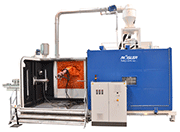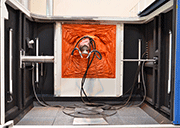E-Archive
Articles
in Vol. 16 - March Issue - Year 2015
Efficient Peening Treatment Of Landing Gear Components

The unique door concept, which opens a large section of the cabin roof, allows quick and safe component loading and unloading from above with a bridge crane and ensures a compact, space-saving design.

The external surface areas of the components including small bore holes are peened with two fixed and one rotating nozzle mounted to a robot. At the same time, internal areas requiring treatment can be peened with a lance.
Rösler GmbH is an international market leader in the production of surface finishing, shot blasting machines, painting systems and preservation lines as well as process technology for the rational surface finishing (deburring, descaling, sand removal, polishing, grinding�) of metals and other components. Besides the German plants in Untermerzbach and Bad Staffelstein, the Rösler Group has branches in Great Britain, France, Italy, The Netherlands, Belgium, Austria, Switzerland, Spain, Romania, Russia, China, India, Brazil, South Africa and USA.
Aircraft landing gear are complex mechanisms consisting of numerous components that are exposed to shock and extremely heavy loading. Shot peening is considered a key technology to extend the service life and prevent premature fatigue of these components, especially for MRO operations (maintenance, repair, and overhaul). For the treatment of various landing gear components a leading European airline is utilizing the shot peening system SP 2000 L R G1 built by Rösler.
A custom engineered solution
Based on customer specifications, this peening unit guarantees not only full compliance with the strict aerospace standards AMS 2430 and AMS 2432, but also allows certification to NADCAP standards. The SP 2000 LR G1 was developed for shot peening a wide range of landing gear components with a length of up to 2,000 mm (about 80�). The components are transferred into the blasting chamber through a motorized "L" shaped door which also opens a large section of the cabin roof. Large and heavy components are simply placed into the blast cabin from above with a bridge crane. When compared with the generally utilised loading cart, this handling method not only allows a much more compact machine design but also a considerably quicker and safer transfer of the raw component into the cabin. Depending on their dimensions, the components are placed and secured on an integrated turntable in either horizontal or vertical position. This flexible design allows the peening of the complete range of landing gear components in one single machine.
After the cabin door is closed, circumjacent pneumatic seals prevent blast media spillage and ensure that the noise level during the shot peening process never exceeds 75 dB.
The external surface areas of the components including small bore holes are peened with two fixed and one rotating nozzle mounted on a robot. At the same time, internal areas requiring treatment can be peened with a lance. The volume / quantity of blast media thrown and the blast pressure are controlled independently from each other. To ensure a continuous and consistent peening process without any interruptions, two double pressure vessel systems are utilised. A sensor in the lower pressure vessel sends a signal when the blast media level falls below a pre-defined value. This signal initiates the opening of the valve of the upper pressure tank, allowing the blast media to automatically flow into the lower tank. The spent blast media is collected through the cabin floor and pneumatically transported to a cyclone, screen separator and spiral, which discharge oversized, under-sized, broken, mis-shapen, unusable media and other contaminants out of the media recirculation system.
"Supervisor System" for control and process documentation
For the equipment and process controls, Rösler developed a special Supervisor System allowing process visualization and documentation on a PC. All component data, programs and process parameters are stored in this system and continuously monitored. This includes the generation of the Almen curves required for controlling the peening process.
For Information:
Barbara Müller
Rösler Oberflächentechnik GmbH
Vorstadt 1, 96190 Untermerzbach, Germany
Tel. +49.9533.924-802
Fax +49.9533.924-300
E-mail: b.mueller@rosler.com
www.rosler.com



























